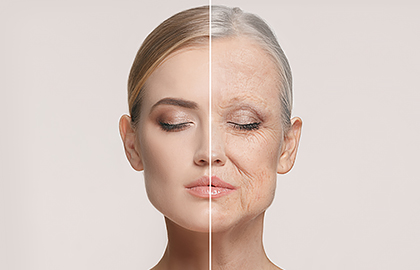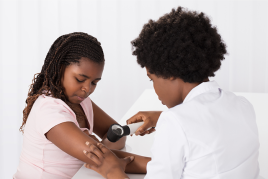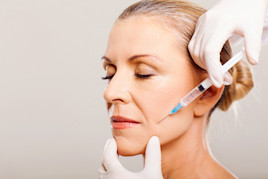Is platelet-rich plasma the secret to younger-looking skin?

If you’re considering getting a vampire facelift, here’s what you should know.
What exactly is PRP?
We all have platelets in our blood. PRP is 3-step procedure that involves having your blood:
Drawn from your arm
Placed into a machine that separates the platelets from the rest of your blood
Re-injected into you (only the part of your blood that contains a high concentration of platelets).
Orthopedic surgeons use PRP to help athletes recover more quickly after an injury.
In dermatology, PRP is being tested as a possible treatment for hair loss. PRP may also speed up wound healing. A few dermatologists are using PRP to give patients younger-looking skin.
If you have PRP to treat signs of aging on your skin, here’s what to expect:
Blood drawn: You would have a small amount of blood (about 2 to 4 tablespoons) drawn from your arm.
Blood taken to lab: The test tube containing your blood would be placed in a medical device called a centrifuge, which separates your blood into layers. One of these layers contains a high concentration of platelets.
Blood injected: Your dermatologist injects the blood that contains the high concentration of platelets into your face or scalp, using a syringe or microneedling (device that looks like a lint roller with tiny needles sticking out of it). To give you immediate results, your dermatologist may also inject a filler.
The entire procedure takes about 45 minutes to one hour.
While PRP may sound like something straight out of a science-fiction novel, some patients are finding that PRP can:
Reduce wrinkles
Plump up sagging skin
Get rid of deep creases
Improve one’s complexion
Diminish acne scars
Another perk: There’s little to no downtime.
Few studies conducted in people
All these benefits have created high demand for a procedure that has little evidence to back it up.
Few studies have been conducted because the U.S. Food and Drug Administration (FDA) doesn’t require the large, complex studies necessary for new drugs. Since PRP uses needles and a centrifuge, the FDA classifies PRP as a medical device. The rules for medical devices are less demanding.
This also means that dermatologists have some unanswered questions about PRP, including:
Why does PRP give some (but not all) patients younger-looking skin?
How many treatments should a patient have to get the best results?
How far apart should the treatments be given?
How much PRP should be injected at one time?
Where should the PRP be injected?
Which equipment (centrifuge, needles) produces the best effects?
Are there any long-term side effects from using PRP to give a patient younger-looking skin?
Is PRP safe?
While dermatologists still have many unanswered questions, the procedure itself appears safe.
You may have a bit of pain, bruising, and swelling afterwards. These tend to go away within a few days.
The biggest risks comes from the way your blood is handled. It’s essential that the blood removed from your body be kept sterile. Otherwise, you could develop an infection.
For your safety, the facility should also follow the same process that transfusion centers use to make sure that your own blood is injected back into you. If you receive someone else’s blood by mistake, you could become very sick.
How long does it take to see results?
If you get results, the full effects appear within a few weeks to months.
How many PRP injections do you need?
Researchers have found that most patients who get results have 3 or more treatments. That means, you’d have to go to your dermatologist’s office 3 or more times to have blood drawn, treated, and injected back into you.
To give their patients more immediate results, some dermatologists inject a filler along with PRP. This allows a patient to see immediate results.
Who can have PRP rejuvenation?
While PRP is considered safe for most people, it’s not recommended for anyone who has one of the following medical conditions:
Hepatitis C
HIV or AIDS
Any type of blood cancer
Cardiovascular disease, which requires taking a blood thinner
Skin cancer in the area to be treated
These conditions affect your platelets, making them unable to deliver the expected results.
How long do the results last?
Results can last as long as 18 months.
How much does it cost?
Because PRP is given to improve a person’s appearance, medical insurance doesn’t cover the cost. In the United States, it’s estimated that the cost of each treatment session can range from $250 to $1,500 per treatment.
Is PRP right for you?
While the results are unpredictable, dermatologists are finding that people want to know whether PRP can give them younger-looking skin.
If you’re thinking about trying PRP, see a board-certified dermatologist. These doctors perform more cosmetic procedures than any other type of medical doctor. They have the in-depth training required to evaluate your skin and tell you what proven treatments can be most effective for you.
If you and your dermatologist decide that PRP is worth trying, it’s important to keep in mind that this is still an unproven treatment. You will be helping to answer the questions that dermatologists still have about this procedure.
Image
Getty Images
References
American Academy of Dermatology. “Fad beauty treatments: Is there science behind the hype?” News release issued February 2, 2015. Last accessed July 31, 2018.
Hersant B, SidAhmed-Mezi M, et al. “Research letters: Efficacy of autologous platelet-rich plasma combined with hyaluronic acid on skin facial rejuvenation: A prospective study.” J Am Acad Dermatol. 2017 Sep;77:584-6.
Houghton V. “A new spin: Examining the theory behind the use of platelet rich plasma for dermatologic procedures.” Dermatol World. 2018;28(5):50-6.
Hui Q, Peng Chang P, et al. “The clinical efficacy of autologous platelet-rich plasma combined with ultra-pulsed fractional CO2 laser therapy for facial rejuvenation.” Rejuvenation Res. 2017 Feb; 20(1):25–31.
Zhang M, Park G, et al. “Review article: Applications and efficacy of platelet‐rich plasma in dermatology: A clinical review.” J Cosmet Dermatol. 2018 Jul 25. [Epub ahead of print].
 Molluscum contagiosum: How to safely treat it
Molluscum contagiosum: How to safely treat it
 Biosimilars: 14 FAQs
Biosimilars: 14 FAQs
 Practice Safe Sun
Practice Safe Sun
 Relieve uncontrollably itchy skin
Relieve uncontrollably itchy skin
 Fade dark spots
Fade dark spots
 Untreatable razor bumps or acne?
Untreatable razor bumps or acne?
 Laser hair removal
Laser hair removal
 Scar treatment
Scar treatment
 Botox
Botox
 Free materials to help raise skin cancer awareness
Free materials to help raise skin cancer awareness
 Dermatologist-approved lesson plans, activities you can use
Dermatologist-approved lesson plans, activities you can use
 Find a Dermatologist
Find a Dermatologist
 What is a dermatologist?
What is a dermatologist?